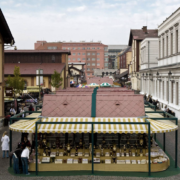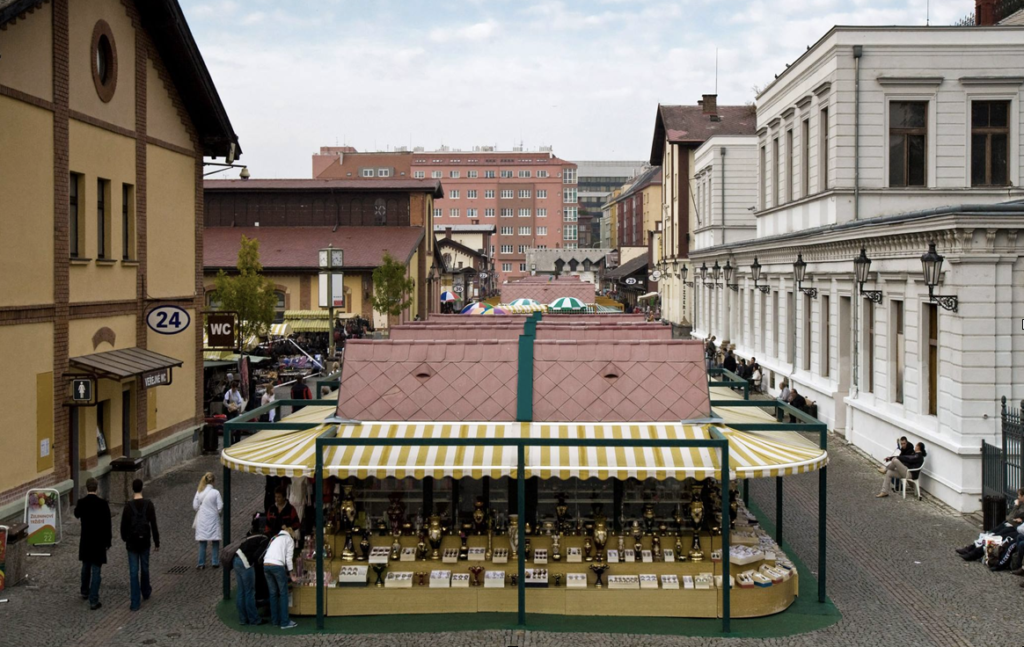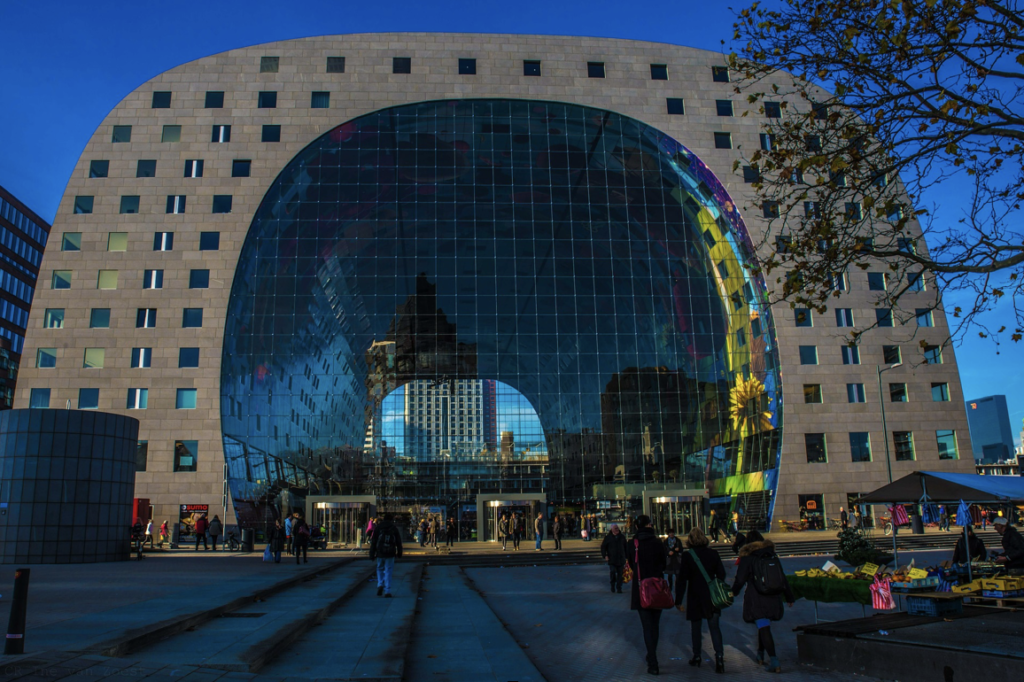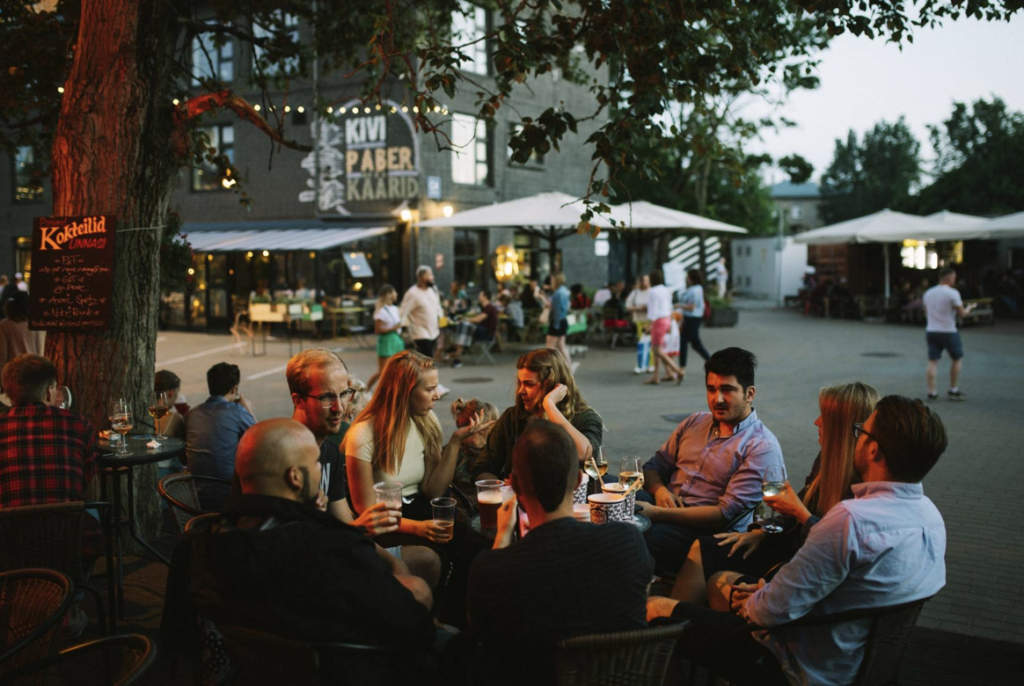Pražská Tržnice’s Future: A Vast Pool of References and Untapped Potential

Last November, the capital city’s long battle over Pražská tržnice’s ownership proved the municipality victorious, meaning the future of the behemoth market and its accompanying grounds now lay in the hands of the city. What the metropolis decided to do with the industrial-compound-turned-marketplace will determine its future place and function in the city.
The market complex, a former slaughterhouse, is nestled between the Vltava river and Holešovice, a young and hip neighborhood marked with museums and artistic spaces. This advantageous location provides Pražská tržnice with an enormous amount of untapped potential. Currently overgrown with weeds and passed over by most, the market grounds could serve as a bridge between the new and old Prague, inhabiting the space of both an evolving marketplace and creative cultural center.

Pražská tržnice’s stalls. Photo courtesy of Facebook.
Slowly, the grounds are tapping into this potential. In April 2019, seven months before the courts came to their conclusion in the case against the former renters of the market, Delta Center, the city of Prague, led by Deputy Mayor Pavel Vyhnánek, began implementing changes to the landscape of the former slaughterhouse and current mish-mosh of markets, retailers, and restaurants. The first things to go were the dilapidated DIY market stalls located between the permanent art-nouveau and neo-renaissance halls. Now, the stalls are all but a memory, with out-door furniture resting in their former places, a nod to the future of the market grounds as a meeting space.
The destruction of food and market stalls is but a small step to a major revitalization project taken on by the city. Currently, an extensive study on the famous market is underway, however, until this study has reached a conclusion the city hopes to host pop up “activities and events,” in hopes of keeping Prague’s residents interested in the revitalization of the grounds.
Deputy Mayor Pavel Vyhnánek hopes to maintain a “healthy mix” of sectors within Pražská tržnice, namely spaces representing retail, food, and culture.
While the study of the grounds underway, the future of the historic complex is still up for grabs. Seeking a change in pace, the people of Prague, including Mayor Zdeněk Hřib, seem to be looking abroad for inspiration for the market grounds’ future reformation. In a November 2019 Facebook post, Mayor Hřib expressed interest in having Pražská tržnice’s future follow in the steps of London’s Borough Market, while simultaneously slamming Prague market’s “visual smog.”

Markthal in Rotterdam, Netherlands.
By only looking to the West, Prague and its residents have turned a blind eye to the successful reformation and revitalization of Tallinn, Estonia’s Telliskivi Creative City. Previously factory grounds built in the 1800s that originally manufactured railway infrastructure and machinery, the complex fell into disarray after Soviet occupation and subsequent freedom in the 1990s.
After privatization, construction started on the dilapidated grounds in 2007, with the large complex’s first tenant moving in during 2009.

Telliskivi Creative City
Intense growth and cultural outreach has marked Tallinn’s creative city in the last ten years. Popular restaurants, film festivals, ice cream shops, art installations, flea markets, a skatepark, and even a preschool have all lived amongst the archaic industrial structures.
Local business reaps the benefits of the hip facelift worn by the grounds. The former railway factory now hosts 250 companies’ headquarters, 30 retail stores, and a dozen restaurants, all of which employ more than 1,500 people together.
Telliskivi’s blueprint, one which has proven successful in the last decade, can serve as an example to Prague that investing in creative pursuits, as well as a local business, promotes the livelihoods and wellbeing of locals, while simultaneously bringing the space acclaim.
Rejuvenation underlines Prague’s industrial ruins. One mustn’t look further than Florence’s Manifesto Market, Prague 9’s Pragovka art district, or Karlin’s recent transformation. However, physical spaces in Prague have yet to blur the spatial lines between creative sectors. Culinary pursuits remain in Manifesto Market, far from the art district of Pragovka. Karlin and Prague 7’s art galleries remain pure, unwilling to mix and mingle with other creative pursuits.
Pražská tržnice, taking a note from Tallin’s Telliskivi should artfully combine and weave these sectors together, placing them amongst one another in the old halls on the former slaughterhouse’s grounds.
With the study determining Pražská tržnice’s spatial and cultural future still underway, the citizens of Prague can only dream and suggest what they want for the withering grounds nestled a stone’s throw away from the city’s historic center.
Support Prague Morning!
We are proud to provide our readers from around the world with independent, and unbiased news for free.
Our dedicated team supports the local community, foreign residents and visitors of all nationalities through our website, social media and newsletter.
We appreciate that not everyone can afford to pay for our services but if you are able to, we ask you to support Prague Morning by making a contribution – no matter how small 🙂 .



